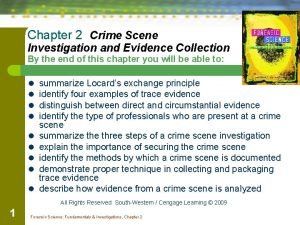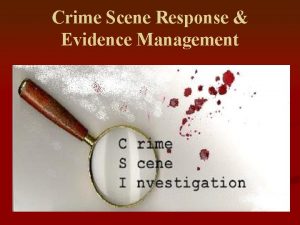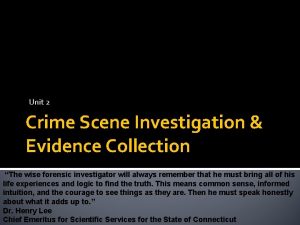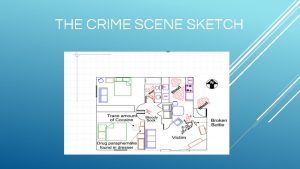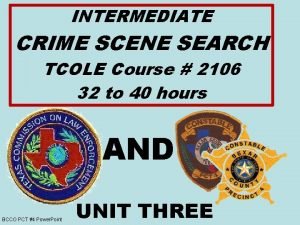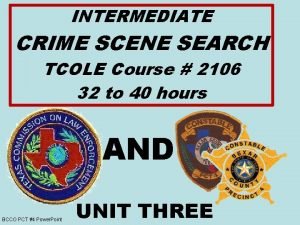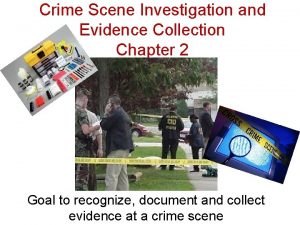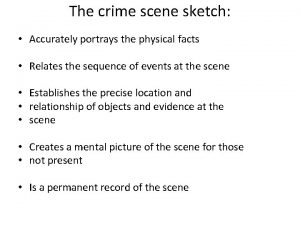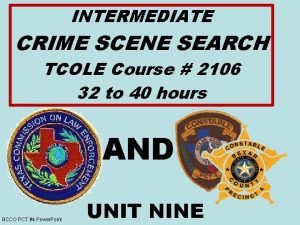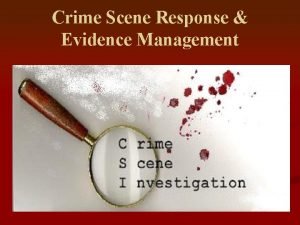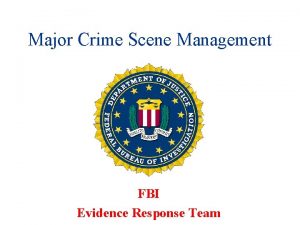Crime Scene Response Evidence Management CRIME SCENE EVIDENCE































- Slides: 31

Crime Scene Response & Evidence Management

CRIME SCENE EVIDENCE n n n 1) 2) 3) 4) 5) 6) Purpose: To provide a basic understanding of crime scene and evidence. Instructional Goal: To provide knowledge, skills and abilities to protect a crime scene. Student Performance Objectives: Define “Crime Scene” Identify what takes priority at a crime scene Define the term “Crime Scene Contamination” Identify the basic procedures that must be followed in securing a crime scene Identify the basic types of evidence. Define the term “Chain of Custody”

Crime Scene Per AR 458, The Associate Warden of Operations (AWO) is responsible to supplement the institution-wide operational procedures, ensuring crime scene protection and the gathering, preservation, and disposal of evidence at their institution. The AWO should designate an Evidence Officer at their institution. n Crime scene is a location where an illegal act occurred, and comprises the area from which most of the physical evidence is retrieved by trained law enforcement personal, crime scene investigators and rare circumstances, forensics scientists.

Operational Procedures for a Crime Scene Per AR 458, the OP should include procedures to: • Staff to notify supervisors of a crime • Initiation of medical response • Protection of the crime scene • Notification of the IG • Lockdown of the institution/facility • Limitation and documentation of the inmates and staff movement • Identification of the inmates in the vicinity of the crime scene • Inspection of the inmates near the crime scene for trace evidence and injury • Movement of inmates away from the crime scene • Photography of any victim, the crime scene, and related inmates and staff • Movement of the deceased persons The IG investigations are the authority for the management of the crime scene from the time of their arrival until the release of the scene. The ranking investigator on the scene has the authority to release the crime scene.

Discover A Crime Scene n n Upon discovery of the crime scene; you must notify your supervisor and take every precaution to ensure that the scene and evidence are protected. Your supervisor should contact medical, if necessary, IG’s office and AWO. Note: The County Sheriff’s Office should coordinate the investigations where a homicide, great bodily harm or a felony that are prosecutable.

Crime Scene Investigation: The use of physical evidence at the scene of the crime and the use of deductive reasoning to gain knowledge of the events surrounding the crime.

Secure & Control The Scene SAFETY AND PHYSICAL WELL BEING of Officers and Inmates, in and around the crime scene, are the initial responding Officers first priority.

Secure & Control The Scene n n Controlling, identifying and removing inmates at the scene and limiting the number of persons who enter the scene is an important function of the responding officer(s) in protecting the crime scene. Identify all individuals at the scene, such as: n Suspects and witnesses; secure and keep isolated from each other. Also isolate the witnesses from each other.

Boundaries; Identify, Protect and Secure Establish the boundaries starting at the focal point and extending outward to include: • Where the crime occurred • Potential exit and entry points • Places where victims/evidence may have been moved • Set-up physical boundaries that can include: cones, tapes, chairs and available staff

Boundaries; Identify, Protect and Secure Document the entry/exit of ALL PERSONS (including Directors, IG, Wardens, Custody and Non Custody Staff and Medical Staff) entering and leaving the crime scene no matter the size of the scene n Boundaries shall be established beyond the initial scope of the crime scene with the understanding that the boundaries can be reduced if necessary BUT NOT EXPANDED as easily n

Crime Scene Contamination/ Protection One of the most important aspects of securing the crime scene is to preserve the scene with minimal contamination and disturbance of physical evidence.

Crime Scene Protection First Responders to an incident should document the placement and/or movement of items at the scene. This includes: • Medical Staff and the items used and/or moved during treatment • Items moved if “USE OF FORCE” was necessary by Custody Staff • DO NOT REMOVE ANYTHING FROM THE SCENE until the scene has been released • DO NOT REPLACE and/or REPOSITION ANY MOVED ITEMS Note: You should escort the medical staff to where the victim is in the area.

Evidence n. Evidence in its broadest sense includes everything that is used to determine or demonstrate the truth of an assertion. Giving or procuring evidence is the process of using those things that are either: a) presumed to be true, or b) were themselves proven via evidence, to demonstrate an assertion's truth.

Evidence n n Photography and sketching of the scene The identification, processing and collection of physical evidence such as: n fingerprints n footwear impressions n hair fibers biological fluids materials for DNA analysis perhaps most important, the application of careful reasoning to the facts n n Note: Remember the chain of custody for the evidence. Ideally, no more than one person should handle the evidence before it is turned over to the person responsible

Evidence Preservation Use measures to preserve/ protect any evidence that could be lost or compromise: 1. Protect from elements if outside: windy, rain, snow 2. Sprinklers systems 3. Bloody clothing should be allowed to dry before packaging. NOTE: Staff should not smoke, chew tobacco, use the telephone or restroom, eat or drink, move any items including weapons (unless necessary for the safety and secure of the institution), adjust thermostat or open doors or windows (maintain scene as found). DO NOT touch anything unnecessarily, empty the trash or REPOSITION items that have been moved.

Evidence Search The goal of a Crime Scene Search is the collection of evidence. n Ever Widening Circles n n Zone or Sector n n Vehicles or Person Strip n n Weapons in Yard Weapon in Building Grid n Weapon in Building

Evidence Preservation Complete an inspection of the surrounding area: • Trash Cans • Inmates Cell • Yard or Tier • Showers

Bloody Evidence When bloody evidence is found, document where it was found. Let it dry completely before putting it in an evidence bag. When packaging, use paper evidence bags NOT plastic evidence bags.

Chain of Custody n Chain of custody (Co. C), in legal contexts, refers to the chronological documentation or paper trail, showing the seizure, custody, control, transfer, analysis, and disposition of physical or electronic evidence.

Documentation n Identify all involved staff and responders Identify all inmates involved and in surrounding area Observations should include: 1. 2. Appearance and condition of the scene (lights off or on, windows being open/closed, smells, liquids, position of furniture or outside weather temperature/conditions) Comments made by witnesses or victim NOTE: Include your own actions or actions of medical staff Request Reports from ALL PERSONS

Remember Life Trump s Crime Scene!!

Cell Phones • Per NRS 212. 165 an inmate in possession of a cell phone (telecommunication device) is a category D felony • Cell phone cases are investigated by the IG as felony crimes and evidence procedure should be the same as any other crime

Cell Phone Dos and Don’ts • • Don’t go through the phone Do turn the phone off Don’t handle the phone without gloves Do note the model number, serial number, and MEID number on the evidence bag

Cell Phone Dos and Don’ts

Cell Phone Dos and Don’ts

Any

Actual Crime Photos

Actual Crime Photos

Actual Crime Photos

Actual Crime Photos

Remember, evidence can be ANYWHERE!
 Evidence crime scene
Evidence crime scene Locard exchange principle
Locard exchange principle Crime scene photography management
Crime scene photography management Natural and forced response
Natural and forced response Natural response circuit
Natural response circuit A subsequent
A subsequent Robin hood hills crime scene photos
Robin hood hills crime scene photos What are the seven s of crime scene investigation
What are the seven s of crime scene investigation Types of crime scene
Types of crime scene Margaret schlosser cause of death
Margaret schlosser cause of death Example of rough sketch
Example of rough sketch Crime scene sketch
Crime scene sketch Method of sketching
Method of sketching Crime scene factoring and quadratic functions answer key
Crime scene factoring and quadratic functions answer key Sketching the crime scene
Sketching the crime scene Mock crime scene scenarios
Mock crime scene scenarios 2106 crime scene investigation
2106 crime scene investigation Intermediate crime scene tcole
Intermediate crime scene tcole Crime scene factoring and quadratic functions answer key
Crime scene factoring and quadratic functions answer key Forensic science chapter 2 vocabulary
Forensic science chapter 2 vocabulary Forensic science begins at the
Forensic science begins at the What should a crime scene sketch include
What should a crime scene sketch include While the csi team is searching the crime scene, _____.
While the csi team is searching the crime scene, _____. Crime scene vocabulary
Crime scene vocabulary Cretaceous crime scene
Cretaceous crime scene Advantages and disadvantages of forensic photography
Advantages and disadvantages of forensic photography Vocabulary crime scene
Vocabulary crime scene What must be included on a crime scene sketch
What must be included on a crime scene sketch What is a grid search police
What is a grid search police Crime scene storyboard
Crime scene storyboard Picktona
Picktona Crime scene
Crime scene

